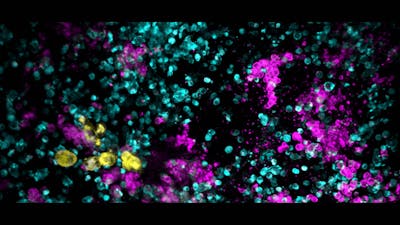- Multiomics and gene network data are used to identify genes that can reverse the biological age of distinct human cell types.
- Technology has the potential to treat major age-related diseases including cardiovascular disease, neurodegeneration, and cancer.

Ichor: Reversing Aging
Treating multiple age-related diseases by making cells younger
Want to help us reverse aging?
The Ichor team is seeking funders and investors to help commercialize their technology.
Synthetic Biology, Therapeutics
Want to help us reverse aging?
The Ichor team is seeking funders and investors to help commercialize their technology.
The Problem

More than 150,000 people die each day across the globe, about two-thirds of them from age-related causes like cancer, neurodegenerative diseases, and cardiovascular disease. If the process of aging could be slowed or reversed, the incidence of these conditions would be dramatically reduced, and more humans would live longer, healthier lives. However, aging is a complex process involving multiple biological systems – there is no single biomarker for aging. Therefore, developing treatments that target the root causes of aging is very challenging.
Our Solution
Ichor is a Validation Project at the Wyss Institute that aims to address this problem using high-throughput genetic screening to identify networks of genes that are strongly implicated in aging processes and develop RNA-based therapies that can make old cells young again.
Product Journey
For several years, Research Fellow Alex Plesa, Ph.D. has been wondering why aging has been treated as an inevitable part of life, and whether there might be a way to alleviate the suffering caused by the spectrum of diseases that afflict all of us as we age. In 2020 he started working on a research project that would eventually become Ichor by applying the genetic screening techniques developed in the lab of Wyss Core Faculty member George Church’s lab to aging.
Plesa and his team started by analyzing human fibroblasts using RNA sequencing and gene network data to identify genes that are highly connected to biological processes that change during aging. They then created a “transcriptome clock” that incorporates information from multiple processes to determine the “age” of a given cell. Finally, they activated candidate genes to see which of them can turn back the transcriptome clock and revert cells to a younger state. This approach allows the team to discover new safe and effective genes for cellular rejuvenation.
Based on the team’s success with skin cells, they were granted Validation Project funding in 2022 to explore Ichor’s ability to reverse aging in hematopoietic stem cells (HSCs) as a further proof-of-concept. Currently, HSC transplant patients who receive HSCs from the oldest donors die sooner than patients who receive cells from the youngest donors. Making older HSCs young again could improve transplant patient survival by up to 50% and increase the overall availability of viable HSCs.
Future Impact
The Ichor team is currently testing their first asset in preclinical mouse models of fibrotic diseases while continuing their discovery work in HSCs. Fibrosis, or the conversion of functional tissue to scar tissue, is a hallmark of many diseases whose prevalence increases with aging, like fatty liver disease, chronic kidney disease, and pulmonary fibrosis. Current treatments can slow or stop this process, but cannot revert scar tissue back to functional tissue. The team aims to demonstrate that their platform can turn back the clock on this process and restore organ function, and also expand their platform technology to HSCs.
Ichor was covered in the Boston Business Journal as part of their series about how the aging population in Massachusetts will affect industries from real estate to healthcare to technology.
Want to help us reverse aging?
The Ichor team is seeking funders and investors to help commercialize their technology.